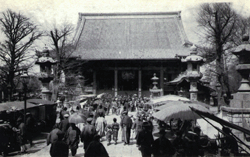
|
It’s probably Senso-ji Temple and the surrounding entertainment district Feel free to send us your stories, memories and old pictures you have of Asakusa. |
|
According to the Edo-Tokyo Encyclopedia: Asakusa was the name given to about half the eastern section of Taito Ward, or the area on the western side of the Sumida River, stretching from the Sumida to the east, the Kanda River to the south and the Omoi River (also known as Koma-arai River) to the north. The district was called Asakusa-ku from 1878 to 1947, when the name was changed to “Taito Ward.” There are several theories to explain the origin of the name “Asakusa.” One links the name with the Ainu word “atsuakusa,” which means “to cross the ocean.”Another theory associates the name with the Tibetian word “asha kusha,” which means “where the holy reside.” Perhaps the most widely-accepted explanation, however, is the description given in the Illustrated Guide of Old Edo (Edo Oko Zusetu): |

|
|
In the Kamakura Period(1185−1333), Shogun Yoritomo Minamoto, unable to find the right craftsmen for the job, brought shrine builders from Asakusa to build the Tsurugaoka Hachimangu Shrine in Kamakura. Leading up to the dispatch of shrine builders, the boat traffic between Asakusa and Kamakura increased, resulting in a greater number of people moving through the area. By the end of the Muromachi Period (1333−1573), a barter market was being held regularly within the precincts of Senso−ji Temple. The Edo Period(1603−1867) saw the capital experience extraordinary growth, eventually absorbing the area then known as Asakusa. In 1590, Shogun Ieyasu Tokugawa entered Edo and chose Sensoji Temple to serve as his prayer hall, offering 500−goku of land (sufficient to raise over 2,500 bushels of rice) to the temple. In 1636, the third Tokugawa shogun, Iemitsu, rebuilt Senso−ji’s main building, which had been burnt down in a fire in April of that year. However, it was destroyed again by fire six years later. During the Meiji Period, on January 15th, 1873, in Meiji period, Tokyo governor Ichio Okubo designated the following five places as parks and notified the ministry of state: *Ueno Kanei−ji Temple The precinct of Senso−ji was named Asakusa Park.
District 1:The area around Senso−ji’s main building−Asakusa Shrine/ Nitenmon Gate/ Niomon Gate/ Five−Storied Pagoda/ Awashima-do Later, District 6 (Rokku) grew into a popular place among Tokyoites. In 1883, a rice field on the west side of Okuyama within the precincts of Senso−ji Temple was made into a pond. The soil scooped out of the rice field was used to create land along the southern and western shores of the pond and to build roads. The pond is also known as Hyotan−ike. |

|
|
Lined with nearly twenty stage, movie and rakugo theaters, the entertainment district of District Six, commonly known as Rokku, attracted a large number of people including soldiers, young laborers called “Decchi” and students on weekends. |
| ◆Sensoji Temple | ◆Asakusa Shrine |
◆Chronological Table (Japanese Only) |
◆Who's Who (Japanese Only) |
Photos:
Shinsen Tokyo Meisho Zukai−Taito City Library (published in approx. 1907)
/ Tokyo Meisho Gajo (published at the end of Meiji Period)
/ Dai−Tokyo Shashin−cho (published in 1930).















